
μMLA
MLA150
MLA300
桌上型無光罩曝光機
無光罩雷射直寫曝光機
專業自動化雷射直寫曝光機
CONFIGURABLE AND COMPACT TABLETOP MASKLESS ALIGNER WITH RASTER SCAN AND VECTOR EXPOSURE MODULES
可根據需求進行配置
具有光柵掃描和向量曝光模組
THE FASTEST MASKLESS ALIGNER FOR R&D, RAPID PROTOTYPING AND SMALL PRODUCTION VOLUMES, DESIGNED FOR BINARY LITHOGRAPHY
最快速無掩模對準器用於研發、快速原型製作和小批量生產,專為二次微影而設計
OPTIMIZED FOR INDUSTRIAL MANUFACTURING, ENSURING HIGH THROUGHPUT AND SEAMLESS PRODUCTION LINE INTEGRATION
優化工業製造,確保高通量並實現生產線自動化整合

µMLA 是一款靈活且可依需求配置的工具,提供兩種曝光模式。標準的 µMLA 使用光柵掃描模式進行曝光,該模式速度快,可提供卓越的圖形品質和精度,且寫入時間與圖形結構尺寸無關。可選配的向量掃描模式,則可以更快速、更準確的對連續平滑曲線圖形 (例如波導) 進行製作。三種光學寫頭提供了高分辨率和吞吐量的選配,使用者可以依需求選擇不同的分辨率和速度,針對特殊應用優化曝光效果。繪制模式 (Draw Mode) 允許對現有結構進行簡單的即時修改,包括用於奈米線及 2D 材料的調整。且提供灰度曝光模式可以創建複雜的 2.5D 結構,例如微光學元件。µMLA 擁有小巧的體積可以輕鬆擺放在桌面,是一款完美的入門研發 (R&D) 工具。
The µMLA is a flexible and customizable tool, and offers two exposure modes. The standard µMLA uses the Raster Scan Exposure Mode for exposures, which is fast and provides excellent image quality and fidelity, while the write time is independent of structure size of pattern density. The optional Vector Scan Mode is designed for patterning continuous smooth curves such as waveguides in a faster and more accurate way. Three optical setups offer a choice of variable resolution and throughput. Each allows easy switching between different resolution and speed configurations to optimize exposure for a given application. The Draw Mode enables straightforward ad-hoc modifications to existing structures and electrical contacts to nanowires or 2D materials. The grayscale exposure mode allows the creation of complex 2.5 structures such as micro-optical devices. With its small footprint, the µMLA fits on a regular table.
您是否因光罩成本高、交貨期長而感到推進遲緩?您是否希望不需要對傳統光罩對準器進行冗長的培訓就能立即執行設計?
探索MLA 150 和數字光刻世界
這種現代化的無光罩激光直寫系統採用快速、靈活、易於使用的解決方案取代傳統技術,具有最高的性能。通過使用數字微鏡器件(DMD)作為動態掩模,MLA 150 克服了物理光罩的缺點。從數位設計到完美圖案化的基底只需幾分鐘,使您的使用者能夠加速量子器件、微機電系統、微光學和生命科學等領域的研究。
為什麼MLA 150 是實驗室的理想選擇?
MLA 150從設計之初就致力於解決學術和工業研發機構面臨的核心挑戰,它直接解決了光罩前置時間長、經常性成本高以及傳統系統曲線陡峭等問題。
專為多用戶設施而打造
減少培訓開銷,並最大限度地延長工具正常執行時間。MLA 150 非常直觀,新用戶只需不到一個小時就能完全勝任獨立工作。其操作軟體和簡化的工作流程非常適合共用實驗室環境,這也是MLA 150 成為領先全球潔淨室必備工具的原因所在。
先進科研及更多應用的卓越靈活性
您的工作獨一無二,您的光刻設備亦當如此。無論是推進前沿研究、通過快速原型加速創新,還是進行高品質的小批量生產,MLA 150 都能適應您的需求,而不是讓您適應設備。
-
廣泛相容各類光阻:
同時安裝一個或兩個不同的雷射波長(375 nm 和/或 405 nm),無需更改硬體即可曝光所有線寬、g、h 和 i 線光阻。 -
輕鬆應對複雜基材:
專用真空吸盤可讓您輕鬆處理難以處理的樣品,包括小至 3×3 mm²的小基片、薄箔和翹曲晶片。 -
創建 2.5D 高深寬比結構:
使用灰度曝光模式可製造複雜的 2.5D 微結構,或使用高深寬比模式在厚光刻膠中形成陡直的側壁圖形,非常適用於 MEMS 和微流體應用。 -
互動式 繪製模式:
在樣品的即時攝像圖像上直接繪製和曝光圖案,特別適用快速製作原型或在石墨烯薄片、奈米線等特殊結構上精確定位電極。
高產速、高精度、不妥協
使用者友善並不等同低性能。MLA 150以卓越的速度和精度,突破製造的極限。
-
亞微米級解析度:
實現最小0.45微米特徵尺寸,輕鬆製備複雜高解析度器件。 -
卓越產能表現:
單次曝光150mm晶片僅需不到16分鐘。 -
先進的自動對準系統:
250奈米級對準精度,數位化補償偏移、旋轉、縮放及剪切誤差 —物理光罩無法實現的精准調整。 -
完美對焦:
動態自動對焦系統確保圖形清晰均勻,輕鬆應對圖案化、翹曲及脆弱基材。 -
極致環境穩定性:
集成溫控層流環境艙(±0.1°C精密控溫),有效抑制熱膨脹效應,確保結果穩定可重複。
大幅降低運營成本
徹底消除光刻工藝中最大且持續的成本——光罩。MLA 150無需光罩採購,省去數周交期等待,同時免去清洗、存儲流程,規避高額破損風險。結合10-20年超長雷射壽命及簡易維護,MLA 150實現行業領先的綜合持有成本。
主要應用
從基礎物理學到應用生物科學,MLA 150 都是值得信賴的工具:
-
奈米加工:
量子設備、二維材料、半導體奈米線 -
MEMS 和 MOEMS:
感測器、致動器、微光元件、微流道 -
材料科學:
新型材料的圖案化加工 -
生命科學:
晶片實驗室、生物感測器
攜手全球數百家頂尖科研機構
全球數百所一流大學和研究中心已選擇MLA 150替代傳統光刻機。
立即聯繫我們,瞭解如何為您的用戶賦能,實現實驗室技術升級。
MLA 300 實現最高的光學品質和精度,標準曝光模組能夠實現最小 1.5 µm 特徵尺寸。
在我們的計畫將會達到更高通量及更高分辨率的寫入模式。
MLA 300 配備全自動化功能,支援可定致的裝載選項,適用於生產環境的軟體設計並採用專利的基材追蹤技術。
MLA 300 通過屏除光罩採購、驗證和管理的需求,因此降低了生產成本和工作量。
由於搭載長效的曝光雷射器 (estimated 10 years at 24/7 production) ,減少消耗使得操作成本大幅降低。
即時自動對焦功能可補償基材的翹曲或波紋,確保圖案精準度。
無光罩微影技術支援對每個晶片進行圖案校正和序列化,能夠完整追蹤產品特性,例如感測器校準。
The MLA 300 achieves the highest optical quality and precision.
The standard exposure module achieves a minimum feature size of 1.5 µm.
Writing modes for higher throughput and higher resolution are on our roadmap.
The MLA 300 features full automation with customizable loading options, software designed for production environments, and patented substrate tracking technology.
The MLA 300 reduces production costs and effort by overcoming the requirement for mask procurement, verification, and management.
Operating costs benefit from a long-lifetime exposure laser (estimated 10 years at 24/7 production) and fewer consumables.
Modularity enables fast maintenance, replacement, or repair. Real-time autofocus compensates for substrate warp or corrugations, ensuring flawless patterning.
Maskless Lithography allows per-die pattern corrections and serialization for full tracing of product characteristics, such as sensor calibration.

PRODUCT HIGHLIGHTS
Substrate size: from 5 mm to 5” Minimum feature size: down to 0.6 µm Maximum write speed (at 4 µm resolution): 200 mm2/min Real-time autofocus system Frontside alignment Easy-to-use operating software 2 available optical setups Choice of exposure Module: Raster and/or Vector scan Variable resolution Draw Mode Wavelengths (Raster Scan): 390 nm or 365 nm exposure wavelength Wavelengths (Vector Scan): 405 nm and/or 375 nm Overview camera for alignment and inspection
多用戶實驗室的理想之選
用戶培訓僅需不到1小時
快速準確的對準
250nm正面/背面對準及誤差補償
卓越的工藝靈活性
雙雷射並行配置,全面覆蓋各類光阻
多種曝光模式可選,兼顧效率與精度
配備專用真空吸盤,輕鬆應對小型基板、薄膜及翹曲樣品
低成本與易維護性
雷射壽命長達 10-20 年
直寫光刻技術
零光罩成本,免維護,無安全風險
灰度光刻模式
輕鬆實現2.5D結構
曝光品質
邊緣粗糙度60nm、CD均勻性100 nm、自動聚焦補償翹曲/波紋基板
最小特徵尺寸
提供兩種不同的寫入模式,最小特徵尺寸可達 0.45 μm
方便用戶
專用軟體與標準化工作流程,操作直觀高效
曝光速度
405nm雷射波長下,150mm晶片全程<16分鐘
Maximum exposure area: up to 400 x 400 mm² Maximum substrate size: 17" x 17" Professional Grayscale Mode Multiple Write Modes Minimum feature size down to 0.5 µm Maximum exposure speed (at 1.3 µm feature size): 370 mm²/ minute Address grid down to 5 nm Modular configuration concept to fit customer application Realtime autofocus Stage map correction Camera system for measurement and inspection Automatic loading system Customer specific laser Multiple data input formats (DXF, CIF, GDSII, Gerber, STL, BMP)
Maximum exposure area: 300 mm x 300 mm Minimum feature size: 1.5 μm Minimum lines and spaces: 2 µm Maximum write speed: 5000 mm2/min (at 405 nm, with one module) Real-time autofocus Overview camera for fast alignment and inspection Front- and backside alignment Temperature-controlled environmental chamber Exposure wavelengths: 405 nm and / or 375 nm

AVAILABLE MODULES
MEMS Micro-Optics Semiconductor Sensors Actuators MOEMS Material Research Nano-Tubes Graphene
Exposure Wavelength
Diode laser sources at 375 nm and/or 405 nm can be mounted together and used interchangeably to expose different photoresists
Exchangeable Chucks
Additional vacuum chucks for challenging samples like small substrates, foils, or warped substrates
Customized vacuum chuck layout upon request
Draw Mode
mport and overlay of BMP files on top of the real-time microscope image – as in a virtual mask aligner; simple lines and shapes can be drawn into the real-time camera image for immediate exposure
Autofocus
Air-gauge or optical autofocus for perfect exposure of small samples (less than 10 mm)
Variable Substrate Sizes
From 3 mm to 6”; up to 8” upon request
Advanced Field Alignment
Automatic field-by-field alignment on individual dies on the wafer for superior alignment accuracy
MEMS Micro-Optics Semiconductor Sensors Actuators MOEMS Material Research Nano-Tubes Graphene
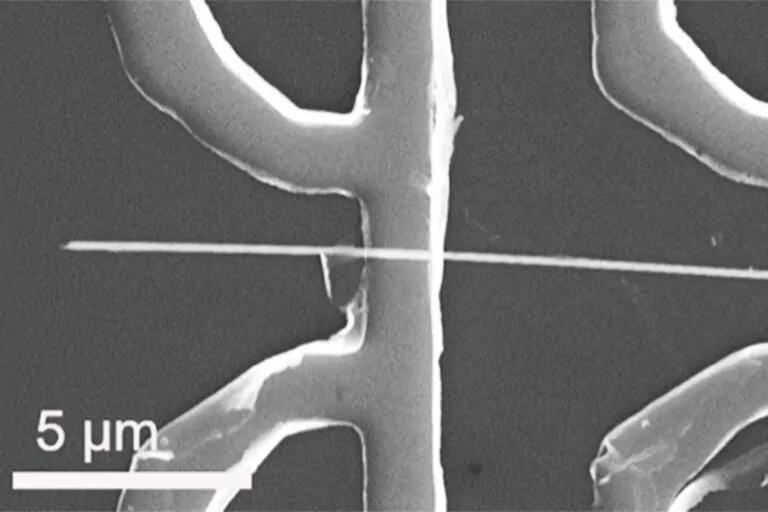
Single Ni nanowires (horizontal line in the image) with two precisely aligned thermometer structures used to investigate Co-Ni alloy magneto-thermopower and magneto-resistance. (Courtesy of Tim Boehnert, University of Hamburg)
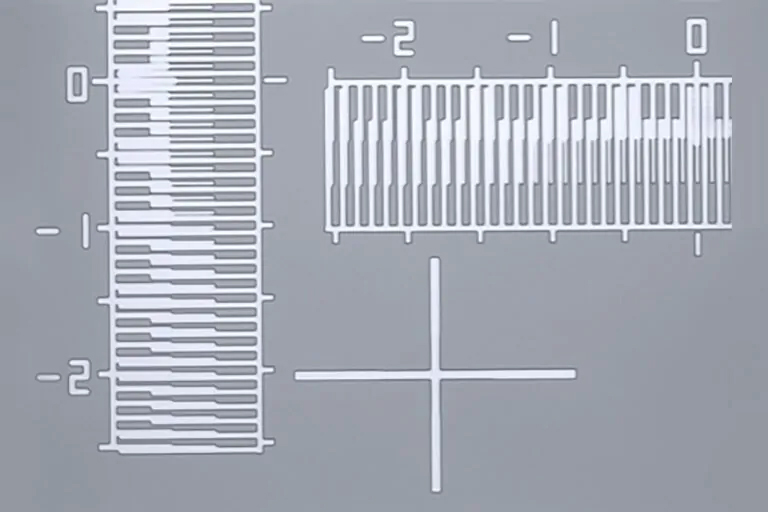
In many applications, several layers need to be exposed on the same substrate. The cameras of the μMLA can automatically detect alignment markers and adjust the position, rotation, scaling and orthogonality of the exposure to the existing structures. The image shows vernier scales and a “cross-in-cross” structure, employed to measure the remaining offset in x and y direction.
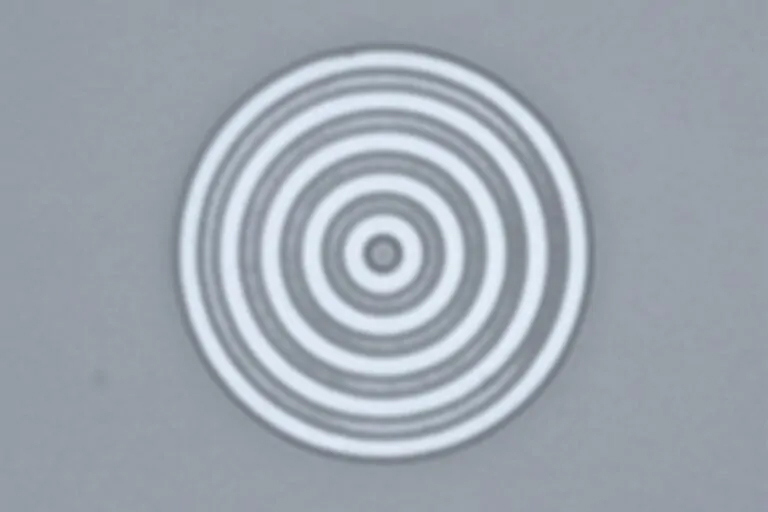
Concentric rings with 1 μm line width were written into the photoresist using the Raster Scan Exposure Mode.
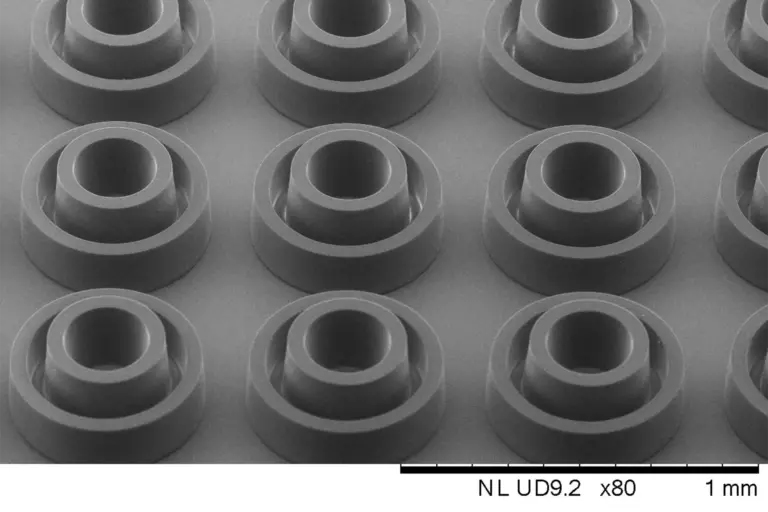
Dual-compartment microcontainers for combination therapy, to achieve a physical separation of two drugs followed by a sequential release. The corresponding paper is linked in our library (DTU Kopenhagen: Christfort, J. F., et al. Adv. Therap. 2022, 5, 2200106)
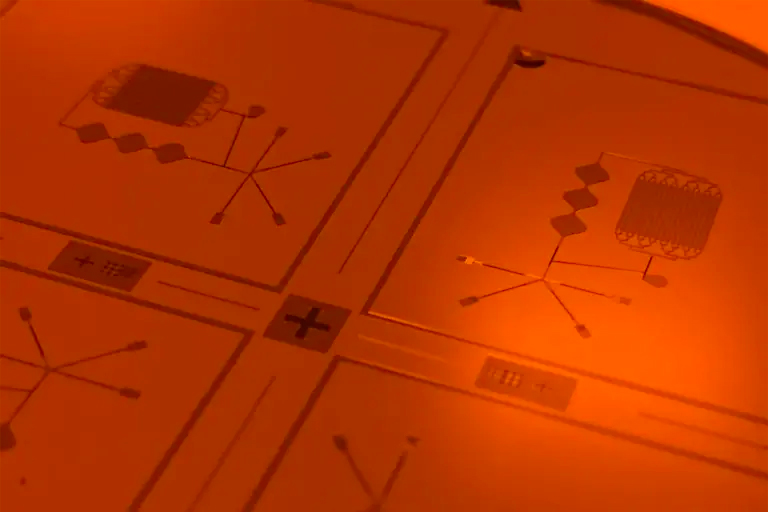
Micro fluidic structures made in two layers of materials: 1. AZ10XT (14 µm, thermally cross-linked by customer) and 2. SU-8 (20µm, aligned to first layer) (Courtesy of Max-Planck-Institute for terrestrial microbiology)
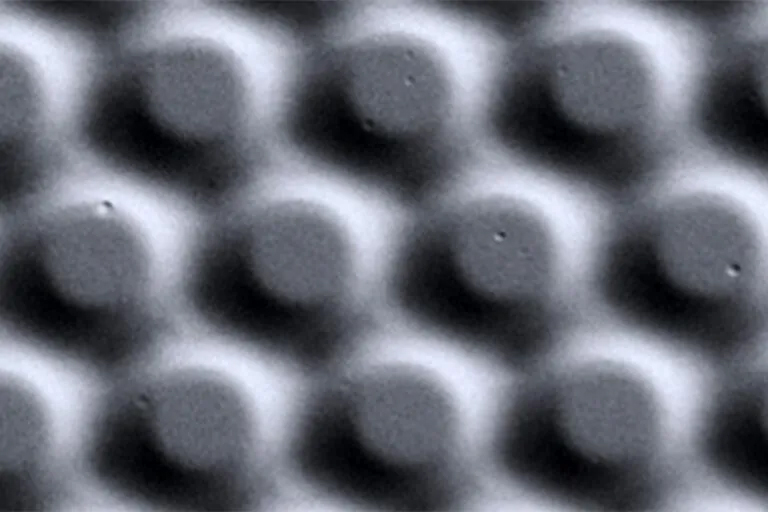
The μMLA also offers a standard Grayscale mode, which allows the creation of structures for a wide range of applications in micro-optics. This example shows micro-lenses written in 15 μm thick AZ4562, with a pitch of 30 μm and a radius of curvature of 16 μm.
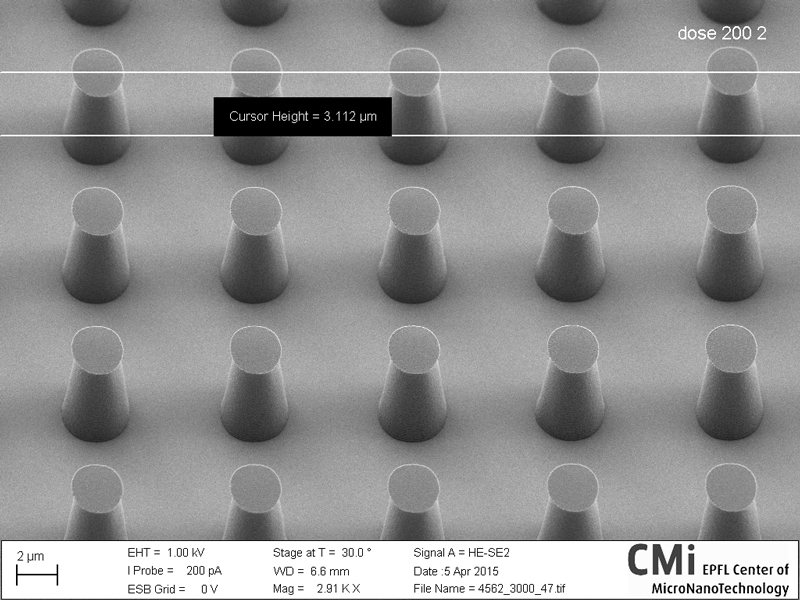
A gear wheel patterned in 800 µm thick SU-8 demonstrates the capability of the MLA 150 to create vertical sidewalls in thick forks, gear wheels, piezoelectric material, bio-, chemical or pressure sensors, or other miniaturized physical devices.
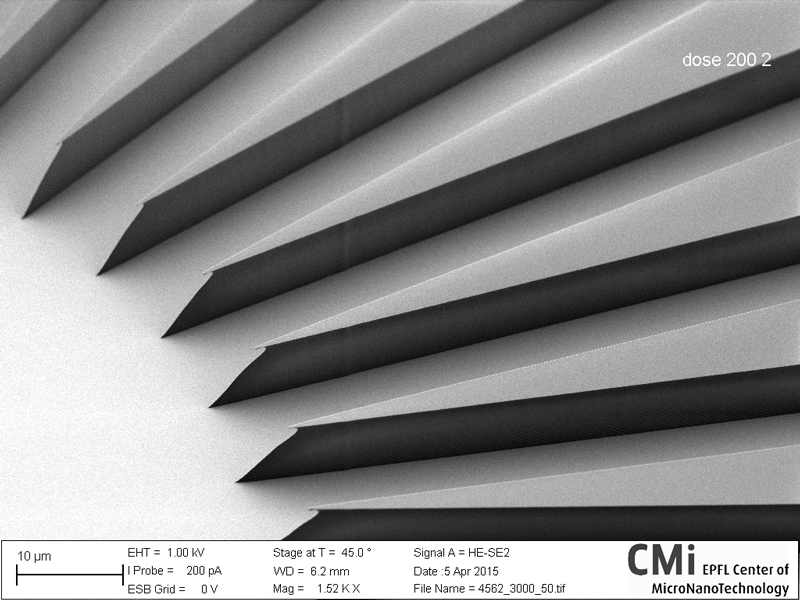
A master for a microfluidic mixer to be transferred by soft lithography in PDMS. The structure is patterned in 100 μm SU-8 with the 375 nm laser wavelength of the MLA 150. This type of structure requires high-throughput for fast large-area patterning and precise stitching to ensure channel smoothness. (Courtesy of CMi EPFL Center of MicroNanoTechnology)
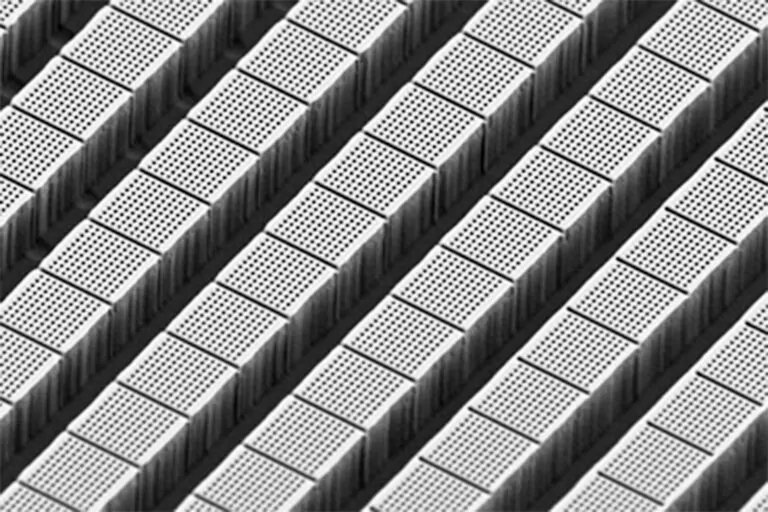
Nanoholes as precisely positioned traps for nanoparticles fabricated using “mix-and-match” lithography. The 100 nm square “nanoholes” patterned with e-beam lithography are separated by the coarse trenches created using the MLA 150, which are precisely aligned to the existing nanohole pattern. (Courtesy of EPFL LMIS1, Lausanne)
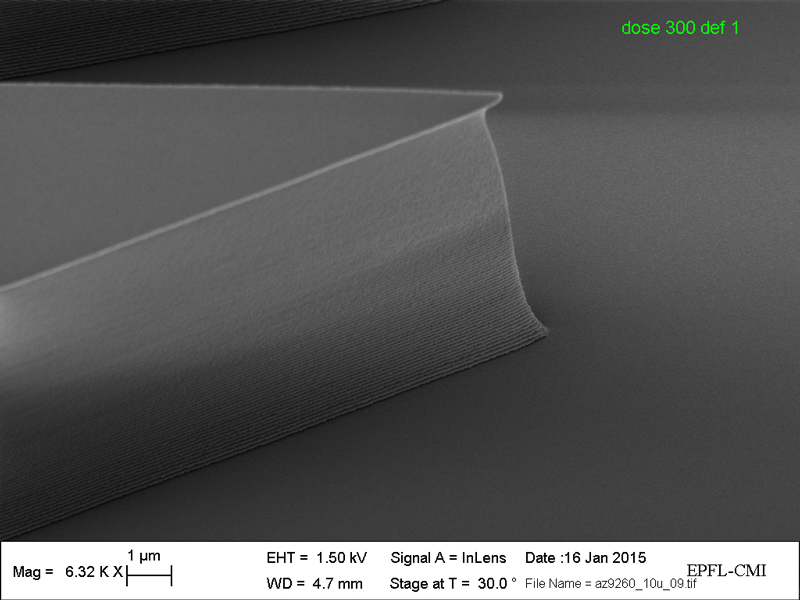
An array of SQUIDs (superconducting quantum interference device) used for the readout of metallic magnetic microcalorimeters (high-resolution particle detectors operated at low temperatures). These devices are microfabricated in large arrays and comprise up to 18 layers with submicron features. The MLA 150 ensures the extreme overlay accuracy crucial for this application. (Courtesy of the Kirchhoff Institute for Physics (KIP), Heidelberg University)
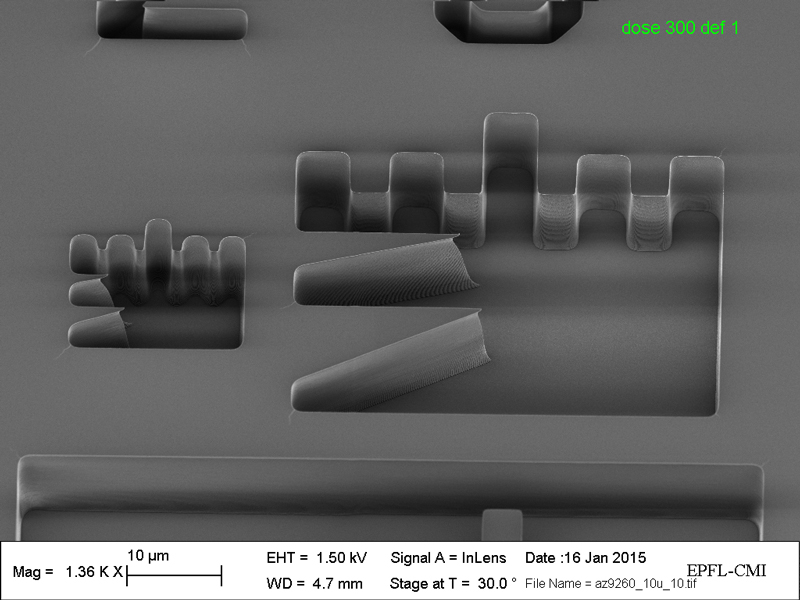
This specific patterning of “OSTEmers” retinal implants shows an example of novel medical implants. Bio-compatible, impermeable, and UV-curable OSTEmers are highly promising for artificial retina. Contactless exposure with the MLA 150 enables the patterning of this material, which is a viscous liquid during processing, and is virtually impossible to work with using other lithography tools. (Courtesy of EPFL, Neuroengineering Laboratory)
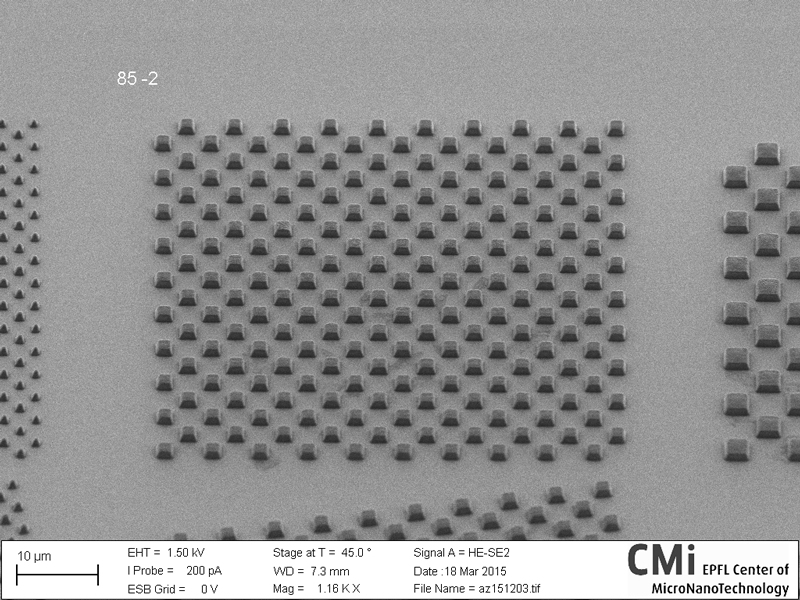
A wafer of superconducting detectors for the South Pole Telescope (SPT) camera. The camera carries an array of over 16000 such devices. Each of them comprises ultra-thin superconducting elements with features as small as 1 μm. Here, the MLA 150 was used to fabricate the Nb leads, which appear as bands in between the pixels. (Courtesy of CNM at Argonne National Laboratory, photo by Clarence Chang)
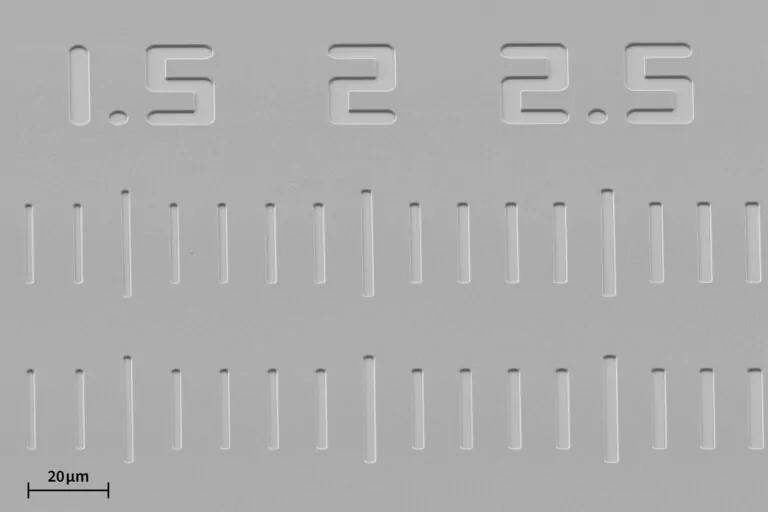
Resolution pattern exposed in a 500 nm layer of AZ1500 showing a minimum feature size of 1.5 µm. (SEM image, viewed with a 45° angle)
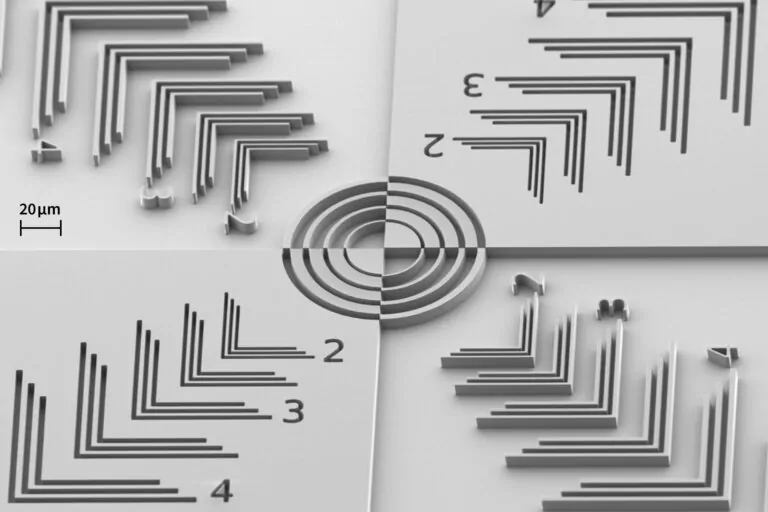
Test structures exposed in a 10 µm layer of AZ 10XT. (SEM image, viewed with a 45° angle)
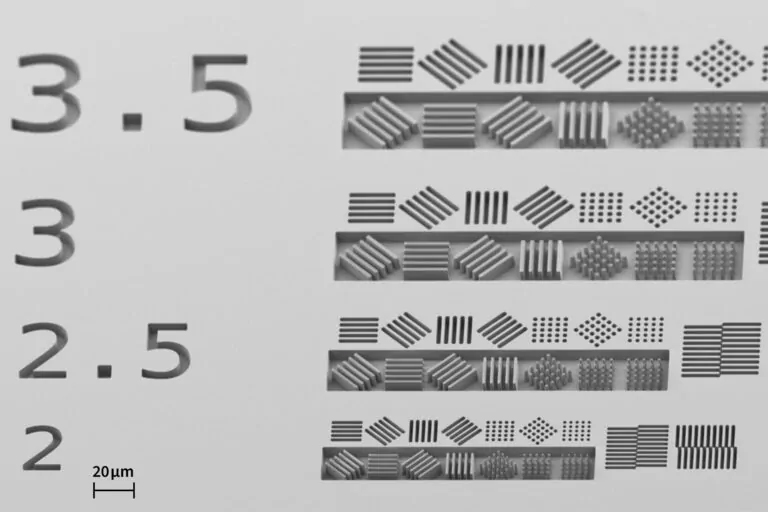
Resolution pattern exposed in a 10 µm layer of AZ 10XT showing an aspect ratio of 1:5. (SEM image, viewed with a 45° angle)
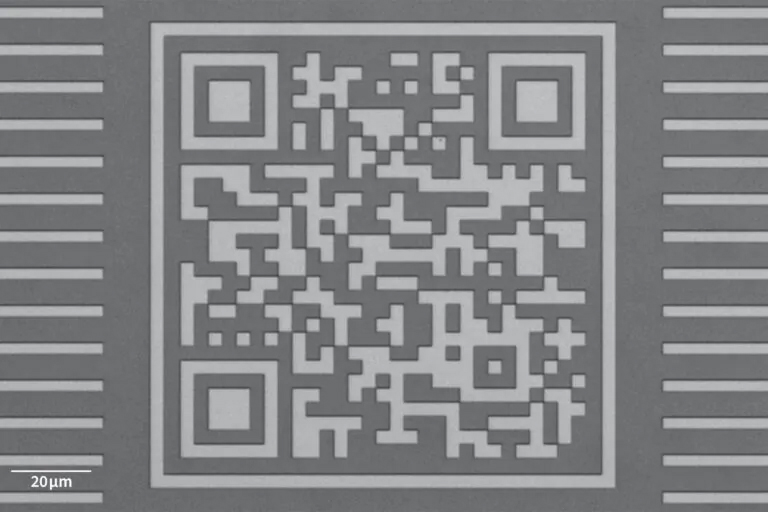
Optical microscope view of a micro QR code exposed in AZ1500 (500 nm) resist.
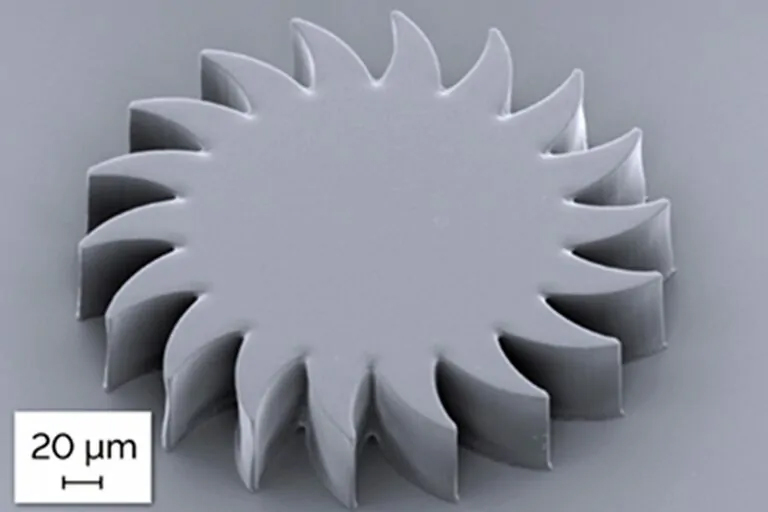
MEMS processes integrate standard microchip technologies with electromechanical components of a diverse range of sizes and materials. Stresses and stress-induced deformations need to be managed carefully to yield correct device properties. The Maskless Aligner technology is ideally suited to make on the fly corrections to the design, if required.
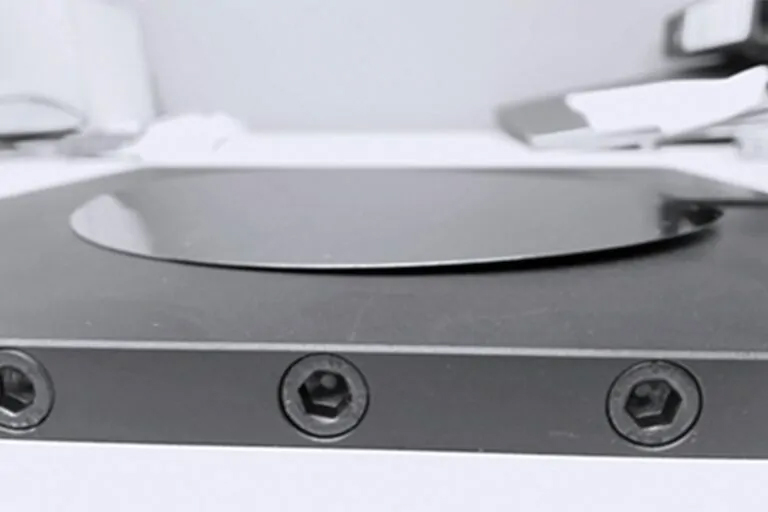
Structuring flexible substrates is challenging as the shape and the distortions vary with applied forces. Maskless lithography offers the unique option of exposing the substrates with warpage-dependent pre-distortions, to maximize yield.
Reach Us
想要知道更多資訊嗎? 沒問題,快與我們聯繫!
© Stella Technology Co., Ltd.



